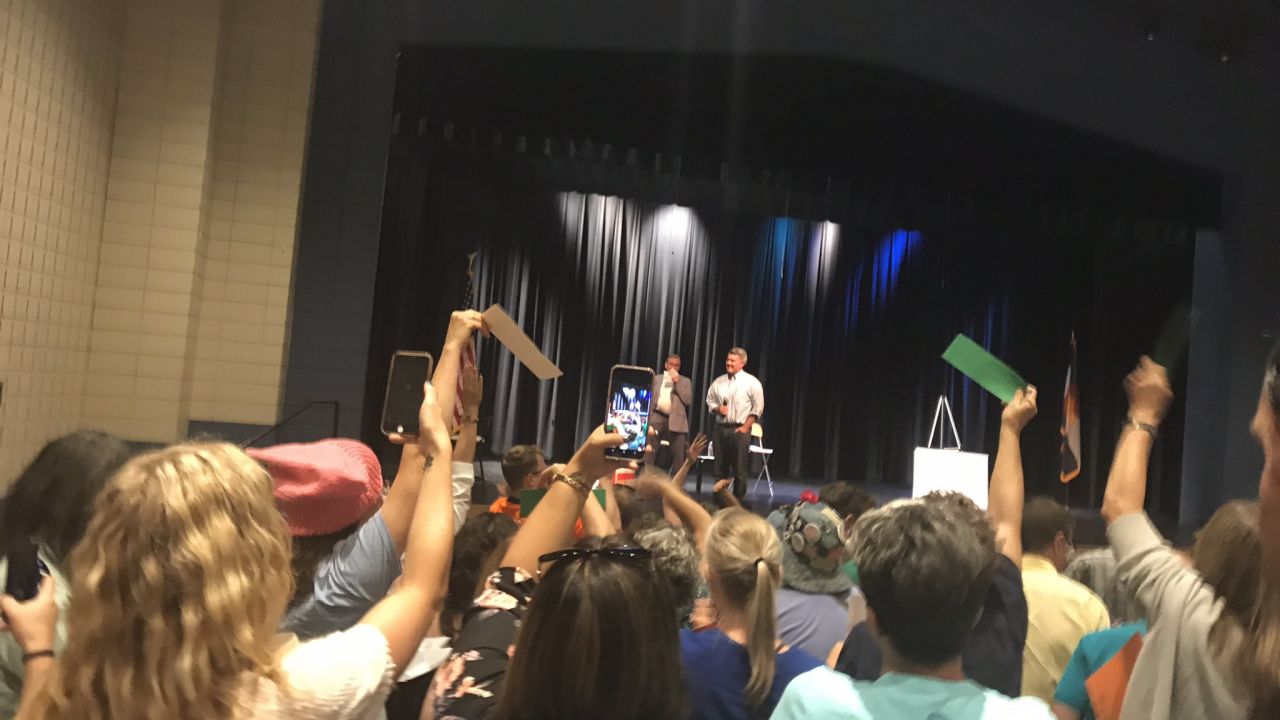
Twitter user Lindsay Apperson (@lmappers) shared this image of constituents questioning Republican Senator Cory Gardner of Colorado at a heated town hall attended by Indivisible members.
This post originally appeared at The Progressive.
Christina Brown runs along the beach near her house in Plymouth, Massachusetts, almost every morning. One day last summer, she saw a swastika painted on a rock. A similar sight greeted Brown just before the last fall’s election. She made a pledge that if Trump won the election, she would do something about it.
“I don’t want to live in a world where people paint swastikas at the beach,” she told me.
Trump did win, and Brown kept her promise. After attending the Women’s March the day after the inauguration in Washington, DC, she started a Facebook page from her couch, Indivisible Plymouth, and invited friends and colleagues to join. She’s now an active member of one of the more than 5,900 Indivisible chapters that have cropped up around the country since November 9.
Indivisible has, in a very short time, emerged as the public face of citizen resistance to Trump. Like the Democratic Socialists of America and Our Revolution, the official outgrowth of Bernie Sanders’ primary campaign, Indivisible has received a surge of interest postelection. Unlike those groups, it didn’t exist beforehand.
— Christina Brown, Member of Indivisible in Pymouth, MA
Less a single organization than a decentralized network, Indivisible grew out of a 23-page document drafted by a handful of former Democratic Congressional staffers in the days after Trump was elected. The subtitle: “A Practical Guide for Resisting the Trump Agenda.”
The former staffers, including Ezra Levin and Leah Greenberg, now the group’s executive director and chief strategy officer respectively, had seen the tea party kneecap their bosses’ attempts to pass progressive policies during Obama’s first term. The guide was their attempt to distill the lessons of the right’s grass-roots army for a more progressive crowd, those interested in stopping Trump’s agenda district by district.
Greenberg says the group’s main model for the guide was the tea party playbook that they saw succeed in their time on Capitol Hill, though the organizing ethos behind it isn’t totally dissimilar from those of the last century’s left-leaning social movements. The tea party itself took several of its cues from the writings of Saul Alinsky, who himself learned to organize from leaders in the Congress of Industrial Organizations.
"No hate. No fear. Immigrants are welcome here." This is what America looks like. Proud to link arms with @UNITEDWEDREAM and partners today. pic.twitter.com/GvN94qDa0m
— Indivisible Guide (@IndivisibleTeam) August 15, 2017
The alter-globalization movement popularized the concept of having mostly small affinity groups come together for big actions, like the shutdown of the World Trade Organization meeting in Seattle in 1999. Similar tactics showed up in Occupy Wall Street more than a decade later, and the Black Lives Matter network also has a decentralized approach, with about three dozen chapters throughout North America guided by shared principles but employing a variety of organizing tactics.
Indivisible chapters vary widely in terms of who shows up and what they do. One common theme is that they tend to be populated by people who are hardly hardened activists. Brown had never been an organizer before, but says her career as an education consultant meant she knew “how to manage a Facebook page and facilitate a meeting.”
From many such small beginnings, a movement was born.
Indivisible’s success comes down to a remarkably simple formula: Give people a no-nonsense handbook for how to hold their elected officials accountable, and then let them do it. Joining is easy, explains Greenberg. Group leaders just have to register their chapter on the Indivisible website and agree to abide by three principles: “Resist Trump’s agenda,” “Focus on local, defensive congressional advocacy” and “Embrace progressive values.”
Chapter leaders and members tend to be ordinary people seeking an outlet for their desire to resist.
“I’m one of those folks who woke up after the election and said that this is not OK,” says Ellen Montanari, of Indivisible 49, in California’s 49th Congressional District in northern San Diego County.
Initially she was terrified by the prospect of Ted Cruz becoming the Republican nominee and made calls during the GOP primary with MoveOn.org. After Trump’s inauguration, she organized a rally outside Congressman Darrell Issa’s (R-CA) office in Vista, California, to save the Affordable Care Act. Since then, she’s joined up with Indivisible and started holding rallies every Tuesday in the same place, each time with a different theme.
Montanari says the group’s rallies and events have drawn between 250 and 826 people. “It should have been 827,” she quips, “but Issa didn’t show up.”
Before the House vote on the American Health Care Act in early May, the Indivisible 49 group was one of many to hold a die-in. A recent action centered on the theme of “cleaning house.” The message was that the constituents in Issa’s district were ready to “sweep him out of the House of Representatives.” Attendees carried mops and buckets, which they then left with his staff.
Montanari had initially hoped to stop organizing events after Trump’s first 100 days, but felt compelled to continue because of the positive feedback she’s gotten: “Somebody told me, ‘You know, Ellen, I am so devastated [about Trump]. But after those rallies I am filled with hope.’”
The group now has about two dozen core members who regularly show up to meetings and take on tasks ranging from planning rallies to organizing postcard-writing events. With school now out for the summer, Montanari says the group has seen an influx of college students and parents with school-age children getting involved.
She told me that the response from Issa and his staff has been increasingly hostile. Now, the city of Vista is seeking to restrict the group’s ability to protest on the sidewalk outside Issa’s office — a move the group is fighting with the help of the ACLU. The city initially suggested that Montanari herself, as the person who applies for the weekly protest permits, should take out insurance to cover liability for the actions, though it has since dropped the request. (She notes that the city’s deputy mayor, John B. Franklin, is a former aide to Issa.)
“As far as I’m concerned, that’s between the city attorney and the ACLU attorney,” Montanari says of the dispute. “My goal is to make sure people can exercise their First Amendment rights.”
Not all chapters face such tense political climates. Plymouth is represented in Congress by Democratic Representative Bill Keating and Senators Ed Markey and Elizabeth Warren, all of whom regard the group warmly. But Brown tells The Progressive she’s eager to keep the group independent of party politics.
The approach seems to be working. At the group’s first meeting in late January, she says, 25 people showed up. “Then we had 60. Then we had 90,” Brown says, adding that there are now nearly 600 people in Indivisible Plymouth’s Facebook group. “People definitely wanted a space for community and grieving.”
The Plymouth group has shifted its focus to turning out voters. The long-term goal is to reach 100 percent voter turnout by 2020, the year of the next presidential election and the 400th anniversary of Plymouth’s founding.
“We really want to focus our attention on who wasn’t able to vote for the first 300 years in Plymouth, and celebrate women’s suffrage,” Brown says. “We are trying to point out that voter disenfranchisement as a political strategy is really anti-American. The other side has tried to co-opt patriotism, and make it look like all these people are trying to vote illegally. Our democracy functions better when it has high turnout.”
While Indivisible groups lean left, Greenberg says, “some of the red-state groups tend to be more affirmatively bipartisan.” Several chapters have sent thank-you cards and made appreciative calls to Democratic and Republican representatives alike who have challenged Trump and shown up to town hall meetings.
The view from Anchorage tonight. pic.twitter.com/4kyX4Q4RwN
— Indivisible Guide (@IndivisibleTeam) August 13, 2017
“Every Indivisible group is an independent entity,” Greenberg says. “We have a policy team that works in Washington to understand what is happening in Congress, and we make recommendations, but [the groups] are independent.”
In turn, the national staff provides resources for door-to-door organizing and how to structure regular meetings. And it has helped coordinate major events, like the June 3 March for Truth that drew protesters to rallies in more than 100 US cities. The protesters called for an independent commission to investigate the Trump team’s ties to Russia and for the president to release his tax returns, something he’s claimed only the media care about.
Until this point, most Indivisible chapters have relied on a few standard tactics: calling and sending letters to representatives, rallying outside their offices and showing up to town halls and public events. In this next stage of the fight to stop the Republicans’ health care proposal — a major rallying cry for Indivisible groups — members are using civil disobedience, a guide to which is included in the group’s toolkit for how to defeat Trumpcare.
“Sit-ins make it clear to senators that we are not OK with them trying to take away people’s health care,” Indivisible policy director Angel Padilla told journalist Sarah Jaffe.
But increasingly, Greenberg says, many Indivisible groups “see electoral work as a natural extension of the work they’re already doing.” She notes that many Indivisible chapters in Georgia’s sixth congressional district worked on Democrat Jon Ossoff’s unsuccessful attempt to flip a Republican-held seat.
Indivisible 49 is now a part of what Montanari calls an effort aimed at ousting Issa, comprised of Indivisible and civil society groups, unions and the district’s Democratic Party clubs.
In Plymouth, Brown’s chapter saw three of its members elected to the town’s equivalent of the city council. But mostly the group is focused on turning out voters.
“We do say we’re nonpartisan and we consider ourselves part of the resistance,” Brown says. “It’s a complicated line to walk, but I don’t want to be part of a divisive group.” The group is still trying to figure out what that means, she adds.
With an average of two chapters in every congressional district, Indivisible could become an electoral force to be reckoned with, whether through running its own candidates or endorsing others. For now, Greenberg says, “We’re really about listening to our local groups [about] where they are and what they need.”
But if Indivisible remains committed to the tea party’s model, then sweeping state and federal races — as the tea party did shortly after its founding — may not be such a distant goal.




